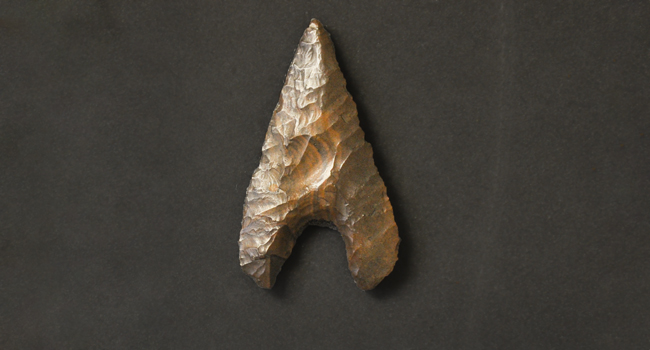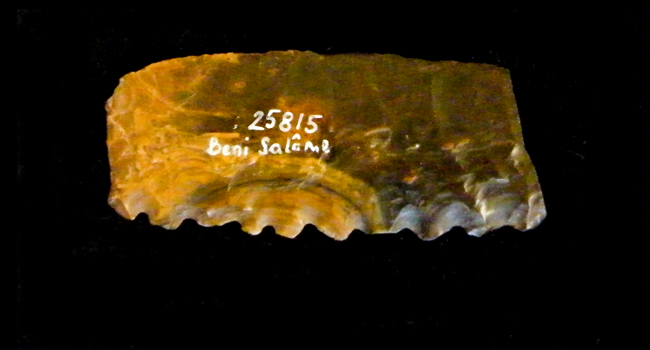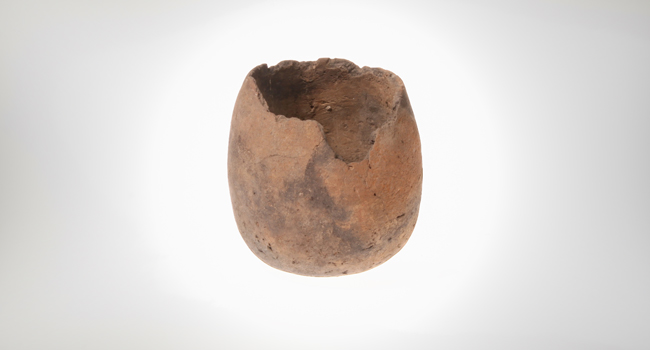The project investigated the mechanisms by which the first settlers arrived along the western edge of the Nile Delta. The research focus was the re-analysis and the re-evaluation of records and finds resulting from prior investigations at the site of Merimde Beni Salama.The project was initiated and directed by Joanne Rowland. Members of the project were postdoctoral researcher G. J. Tassie and the student assistants Sebastian Falk, Sophie Schmidt and Georg Cyrus as well as the senior fellows Giulio Lucarini and Mennat-Allah El Dorry.
Research
After its discovery by Hermann Junker in the 1927-8 survey season, and excavation by Junker, Per Lugn and Hjalmar Larsen from 1929-39, Merimde Beni Salama was re-investigated by the Egyptian Antiquities Organisation (EAO, now the MoA) directed by Afifi Badawi, by Zahi Hawass, Fekri Hassan and Achilles Gautier in 1976, and by Josef Eiwanger on behalf of the German Archaeological Institute from 1977–1982. However, since these investigations took place, new archaeological techniques have become available. Therefore, in 2013 the research project (A-2-4) The Neolithic in the Nile Delta was instigated, with the aim of re-visiting the evidence in light of the new possibilities not only with methods, but changing research perspectives. The project focuses on research at sites along the western edge of the Nile Delta, particularly the Neolithic site of Merimde Beni Salama. This project has and hopes to make continued use of many of the scientific techniques now available, such as AMS dating, stable isotope analysis, thin section analysis, organic residue analysis, use wear analysis, electronic microscopy, geophysical surveying, and many others. Geoarchaeological and environmental research is also helping to shed light on the reasons for choosing certain settlement locations over others, and the extent to which these choices were determined by the regional environment and changing climate. These various methods will help to generate reliable data to distinguish the beginnings of, and development of, Egyptian agriculture in the Neolithic.
A key element of the Topoi (A-2-4) project has been the identification and recording of objects excavated at Merimde Beni Salama in the 1930s, and presently housed in various museums around the world. The writing on these objects by the previous excavators has helped to reconnect many objects, not only to their original excavation grid square and depth below surface, but in some cases has enable their positive identification with Merimde Beni Salama for the first time. Locating existing published and unpublished documentation and photos has also been a key element of the project, and this material is also helping us to better understand the site of Merimde Beni Salama, and allowing for re-contextualisation of the finds with their documentation. In this way the museum collections have helped to inform the present archaeological research and also to (re)construct of the ancient past of these early settlers.
Results
The environmental context in which individuals and groups first settled on the fringes of the Nile Delta.
Reconstruction of the Palaeoenvironment
Through a series of environmental cores, in conjunction with examination of the sediments in context, a section plan has been created that incorporates data running from the Middle Palaeolithic terraces at el-Khatatbah to those on the Wadi el-Gamal at Merimde Beni Salama, across the Neolithic site and across into the Nile Valley. It is now possible to estimate the local environment at the various times of settlement at the site. Sedimentary analysis was carried out in collaboration with Mohamed Hamdan, Cairo University and in 2013 in cooperation also with Judith Bunbury, University of Cambridge in 2013.
Geophysical Survey
A geomagnetic survey carried out by Cornelius Meyer and Dana Pilz of Eastern Atlas Berlin was successful in establishing the extent of archaeological features present on and adjacent to the current registered archaeological site of Merimde Beni Salama. Initial test trenches have confirmed these results, suggesting a much larger settlement area than known previously. They highlighted the presence also of a disused channel running across the site. Further magnetic survey by Kristian Strutt of the University of Southampton in 2015, also produced interesting results which led to the discovery of hitherto unknown structures on the Wadi el-Gamal.
Research into plant and animals remains
Research both on site and into the collections’ based material was carried out by Mennat-Allah El-Dorry (Ministry of Antiquities) at Merimde Beni Salama, Cairo, Stockholm and Heidelberg. Mennat-Allah El-Dorry, who was awarded a short Senior Topoi Fellowship to undertake this research, identified several hitherto unrecorded species within the samples in Stockholm and Heidelberg.
Organic residue analysis was carried out in collaboration with Julie Dunne (University of Bristol) on ceramic sherds of different types from the Medelhavsmuseet in Stockholm which revealed that we are able, still, to get information from sherds excavated in the 1920s and 1930s as to different types of animal and plant species contained. Further research is planned.
The members of the project have identified substantial samples of animal remains in the collections in Stockholm and Heidelberg and with future funding macro and stable isotope analysis will be carried out on these remains to obtain additional information as to the origins of these domesticated species. In turn, human skeletal remains from a limited number of burials are held within the collection in Stockholm and it may be possible to conduct both osteological and isotope analyses on these in the future. Further comparative data is available due to the chance finding of six human burials during the new excavations in at around Merimde Beni Salama.
Interaction between the sites of the western Delta and other sites in close and more distant proximity, including the central and eastern Delta, the Levant and the Western Desert, Faiyum and the Nile Valley.
Museum Research
From late 2013 until mid-2016 research was undertaken in museum collections around the world that house collections from Merimde Beni Salama. This involved research on three continents, in several institutions and with the help and goodwill of many people. This research included the identification and recording of objects excavated at Merimde Beni Salama during the 1930s, primarily by Hermann Junker, and also Per Lugn and Hjalmar Larsen. This data was entered into a database, which forms the core of the GIS (see below). This part of the project has allowed for the recording of many objects that had previously not been published. It also highlighted the need for further analysis of both botanical and faunal remains in some of the collections.
Database/Geographical Information Systems
Edition Topoi Collection
The Neolithic in
the Nile Delta
The Neolithic in the Nile Delta, 2017, Edition Topoi, DOI: 10.17171/1-9
The data images and details collected during the A-2-4 project are publicated as a data collection on the Edition Topoi website. A GIS was constructed by Sophie Schmidt and Georg Cyrus which holds satellite, map and excavation/survey grid data for all of the previous – and current – investigations at Merimde Beni Salama. It is enabling spatial analysis into the distribution of finds across the site in order to further investigate the changing use of the site over time and also the changing nature of contacts between Merimde Beni Salama and other regions. This analysis is ongoing in conjunction with new research in the field.
Finds’ Analysis
Analysis of the ceramic, lithic and other small finds’ assemblages have been conducted on site during the course of the fieldwork. The interpretation of these new finds are not only being guided by recent research and survey/excavations in the Faiyum and central Nile Delta, but by the project’s re-analysis of museum-based finds. Inter-site comparison is helping us to comprehend the temporal directionality of influence as represented by the lithic toolkit and ceramic assemblages present. At present the Neolithic sites in the West Delta are earlier than those in the East (due to very limited known evidence at present). This seems peculiar given the natural entry point into Egypt is via the Sinai, but more focus maybe needs to be given to other possible routes by which domesticates arrived, including seaborne (Mediterranean, Red Sea) and others. The ceramics in Lower Egypt bear very little resemblance to those found in the Western Desert and Upper Nile Valley. However, bifacial technology appears earlier in the Western Desert than it does in the Nile Basin.
The chronology of the Neolithic within Egypt on an intra- and inter-regional scale
Chronological Investigations
OSL samples have been taken on the Wadi el-Gamal and subject to an export permit, will provide crucial new dates to confirm the time(s) at which modern humans were moving through the area during the Middle Palaeolithic. It will then be possible to consider how this fits in within other existing theories of human movement.
The first AMS 14C samples were taken directly on plant remains from the Medelhavsmuseet in Stockholm and will be published in the proceedings of the Revolutions workshop. These results give direct dates for certain species and they will be compared alongside the previous conventional dates on organic remains from Merimde Beni Salama. The new dates do not provide earlier dates, although a pre-5000 BC date is still suspected for the first evidence of Neolithic settlement.
Recent research by colleagues working in the Faiyum has shown that there is no gap between the Qarunian Epipalaeolithic (conventionally dated to 7,570 to 6,200 cal BC) and the Early Faiyumian Neolithic (5,550 to 4,650 cal BC). The early sixth millennium appears to have been a transitional period in the Faiyum prior to pastoralism being introduced into the region. Throughout the Western Desert, mixed pastoral groups had existed from ca. 6,100 cal BC. Mixed farming with domesticated flora and fauna only occurred in the Faiyum during the Late Faiyumian (4,650 to 4,200 cal BC).
Workshop “Revolutions”
A workshop was held to discuss research into the Neolithic within its wider North African, Levantine and Southern European context. “Revolutions. The Neolithisation of the Mediterranean Basin: The Transition to food Producing Economies in North Africa and Southern Europe” was held from October 29-31 2015 at Topoi House, Dahlem. The conference included participants from around the world, and included a substantial discussion element, to be included in the publication.
Beyond the presentation of results in several publications and at international conferences the project´s work has been discussed in the media.



